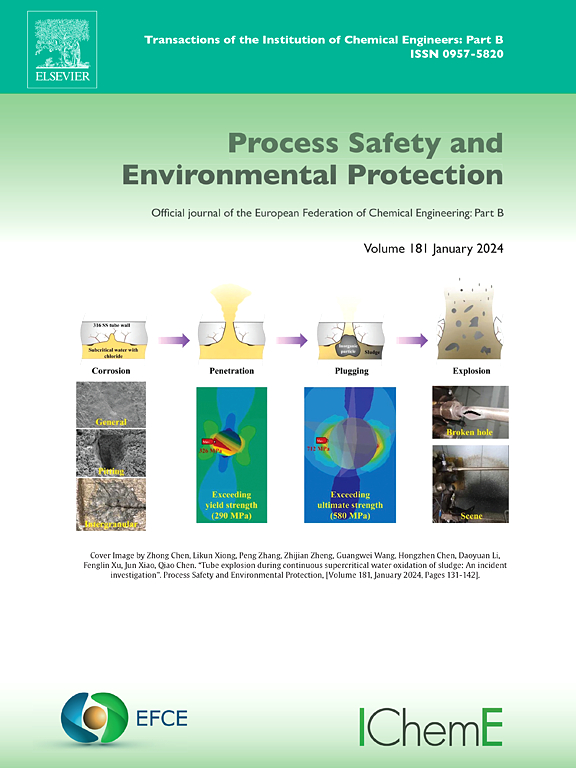Mechanism of enhanced rubidium extraction from biotite via magnesium nitrate-assisted acid leaching: Experimental and DFT theoretical insights
IF 6.9
2区 环境科学与生态学
Q1 ENGINEERING, CHEMICAL
引用次数: 0
Abstract
This study explored the mechanism and optimization of technical condition for enhanced rubidium extraction by utilizing magnesium nitrate in the sulfuric acid leaching process of biotite. The extraction efficiency of rubidium was significantly improved with the addition of magnesium nitrate. Under optimized conditions, the Rb leaching efficiency achieved 95.9 %. Concurrently, the leaching efficiency of impurity ions such as iron and aluminum were effectively reduced. Compared with the sulfuric acid leaching process, the iron leaching efficiency decreased from 90.3 % to 67.9 %, and the aluminum leaching efficiency decreased from 64.8 % to 17.0 % in enhanced process. The crystal structure transformation of biotite was systematically investigated using SEM-EDS, XRD, FTIR, FIR, and Mossbauer techniques. These analyses revealed significant modifications in the interlayer spacing, tetrahedral coordination, and octahedral structure. The DFT calculations have confirmed that the ion exchange process involves the participation of Mg2 + and H+, which play a critical role in facilitating the rubidium extraction. This interaction resulting in an increase in the (001) interplanar crystal spacing of biotite from 0.993 nm to 1.00 nm. The results demonstrated that magnesium nitrate functions as an exceptional enhancer for the acid leaching of rubidium from biotite. This process provides a novel strategy for the development of more efficient and environmentally sustainable processes for the recovery of valuable metals from micas.
硝酸镁辅助酸浸从黑云母中提取铷的机理:实验和DFT理论见解
研究了硝酸镁在黑云母硫酸浸出过程中强化提铷的机理及工艺条件的优化。硝酸镁的加入显著提高了铷的萃取效率。在优化条件下,Rb浸出率达到95.9% %。同时,有效降低了铁、铝等杂质离子的浸出效率。与硫酸浸出工艺相比,强化工艺的铁浸出率从90.3 %下降到67.9% %,铝浸出率从64.8 %下降到17.0 %。采用SEM-EDS、XRD、FTIR、FIR和穆斯堡尔技术对黑云母的晶体结构转变进行了系统的研究。这些分析揭示了层间距、四面体配位和八面体结构的显著变化。DFT计算证实了离子交换过程涉及到Mg2 +和H+的参与,它们对铷的萃取起着关键作用。这种相互作用导致黑云母的(001)面间晶体间距从0.993 nm增加到1.00 nm。结果表明,硝酸镁对黑云母中铷的酸浸有特殊的促进作用。这一过程为开发从云母中回收有价金属的更有效和环境可持续的过程提供了一种新的战略。
本文章由计算机程序翻译,如有差异,请以英文原文为准。
求助全文
约1分钟内获得全文
求助全文
来源期刊

Process Safety and Environmental Protection
环境科学-工程:化工
CiteScore
11.40
自引率
15.40%
发文量
929
审稿时长
8.0 months
期刊介绍:
The Process Safety and Environmental Protection (PSEP) journal is a leading international publication that focuses on the publication of high-quality, original research papers in the field of engineering, specifically those related to the safety of industrial processes and environmental protection. The journal encourages submissions that present new developments in safety and environmental aspects, particularly those that show how research findings can be applied in process engineering design and practice.
PSEP is particularly interested in research that brings fresh perspectives to established engineering principles, identifies unsolved problems, or suggests directions for future research. The journal also values contributions that push the boundaries of traditional engineering and welcomes multidisciplinary papers.
PSEP's articles are abstracted and indexed by a range of databases and services, which helps to ensure that the journal's research is accessible and recognized in the academic and professional communities. These databases include ANTE, Chemical Abstracts, Chemical Hazards in Industry, Current Contents, Elsevier Engineering Information database, Pascal Francis, Web of Science, Scopus, Engineering Information Database EnCompass LIT (Elsevier), and INSPEC. This wide coverage facilitates the dissemination of the journal's content to a global audience interested in process safety and environmental engineering.
 求助内容:
求助内容: 应助结果提醒方式:
应助结果提醒方式:


